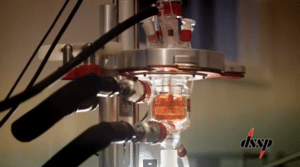Latest News
[Via Satellite 08-22-2014] Digital Solid State Propulsion (DSSP) is nearing the long awaited test of its Electrically controlled Solid Propellants (ESPs) — a new alternative to hydrazine and a potential competitor for electric propulsion. In January 2014 the company proved its thrusters, which are powered using a technique called double-diffusion, successfully reached an efficiency that places them in the regime of electric propulsion, but with a chemical system. The first in-orbit test was originally scheduled for March, but has since been rescheduled for NASA’s fourth Commercial Resupply Services (CRS 4) mission aboard a SpaceX Falcon 9 in September.
“What we are trying to develop is a true dual-mode thruster where we can operate it at high thrust and relatively low Specific Impulse (Isp), which is chemical efficiency, and low thrust and high Isp [which is electric efficiency],” Wayne Sawka, CEO of DSSP, told Via Satellite. “The benefit of a dual-mode thruster is you would be able to get through the Van Allen belts very quickly, but then have the electric propulsion high Isp when you’ve made it into orbit … it falls in between the payload of a fully electric system versus a fully chemical system. I think that’s the Holy Grail for a lot of people, and we are making progress towards that on our solid propellants.”
DSSP’s thrusters will have its inaugural flight on NASA’s Special Purpose Inexpensive Satellite (SpinSat), where they will be used to control the spacecraft. Once in space, a laser pointed at the satellite will track its rotation and translation from a Maui, Hawaii-based observatory. Sawka hopes the in-orbit data will build confidence in the system to fly on future missions.
Electrically controlled solid propellants are a spin-off technology that Sawka helped develop while working at Aerojet Rocketdyne. In 2005 he created DSSP around the technology, by which a solid rocket motor is able to turn on and off without any moving parts. DSSP now has 14 to 15 different active programs for the technology that are valued from tens of thousands to millions. The other appeal is the propellant’s environmentally friendly characteristics. It is not poisonous, and requires no pressurized tanks. According to Sawka, the U.S. postal service will even allow it to travel in the mail.
“In our solid propellants we have a toxicity that is among the lowest out there. We are somewhat greener than AF-M315E that’s being touted as the green monopropellant. CO2, Nitrogen and water are our only combustion products. The fuel we use in our solid propellants is polyvinyl-alcohol, which is actually used in a lot of food products,” he said.
The unique characteristics of DSSP’s electrically controlled solid propellants have captured the attention of customers outside the satellite industry as well. Sawka said oil and gas customers have found electric monopropellants very applicable to their work, and Hollywood is interested in the micro-thrusters for special effects.
Currently the U.S. Missile Defense Agency (MDA) is funding a significant amount of DSSP’s work for tactical non-satellite purposes. The Defense Advanced Research Projects Agency (DARPA) has a plasma cannon test in November that will incorporate the technology, and Raytheon Missile Systems plans to use the company’s ESPs for anti-vehicle technology and for boost phase propulsion.
Sawka said DSSP is actively working with small satellite companies Moog and Pumpkin, and has experimental work going on with Pennsylvania State University and the University of Alabama Huntsville. A company called Illinois Rockstar is also working on a theoretical model of the propellants, and the U.S. Navy is close to entering a Cooperative Research and Development Agreement (CRADA) with DSSP.
“The next big feat for us will be to do our own satellite test. This will be the test of the larger 1-newton thruster. The thought is to do that demonstration as part of our MDA work, so we’re planning that flight for about two years out. What we would be looking at is probably a sounding rocket flight duplicating some of the tactical benefits for the MDA rather than a space mission,” said Sawka.
Sawka admitted the next 24 months will largely focus on tactical purposes for MDA instead of satellite, but DSSP has intentions of scaling up its thrusters for use on larger satellites. The company has a second demonstration with an undisclosed customer for a CubeSat mission in 2015. DSSP is currently applying for phase two funding from MDA for a liquid thruster, which will ultimately have both military and satellite applications.
“Pushing it to CubeSats was to show that we could make [our system] fit in a CubeSat, but I really think our sweet spot for this type of propulsion system is probably the 20 to 50 kilogram range for the solids, and then as far as much larger satellites go, if we are successful in the next few years on our MDA work on the monopropellant, that could certainly be scalable to larger systems,” said Sawka. “And when I say larger systems I mean all the way up. There would be no reason it couldn’t fly on a very large satellite.”
Get the latest Via Satellite news!
Subscribe Now